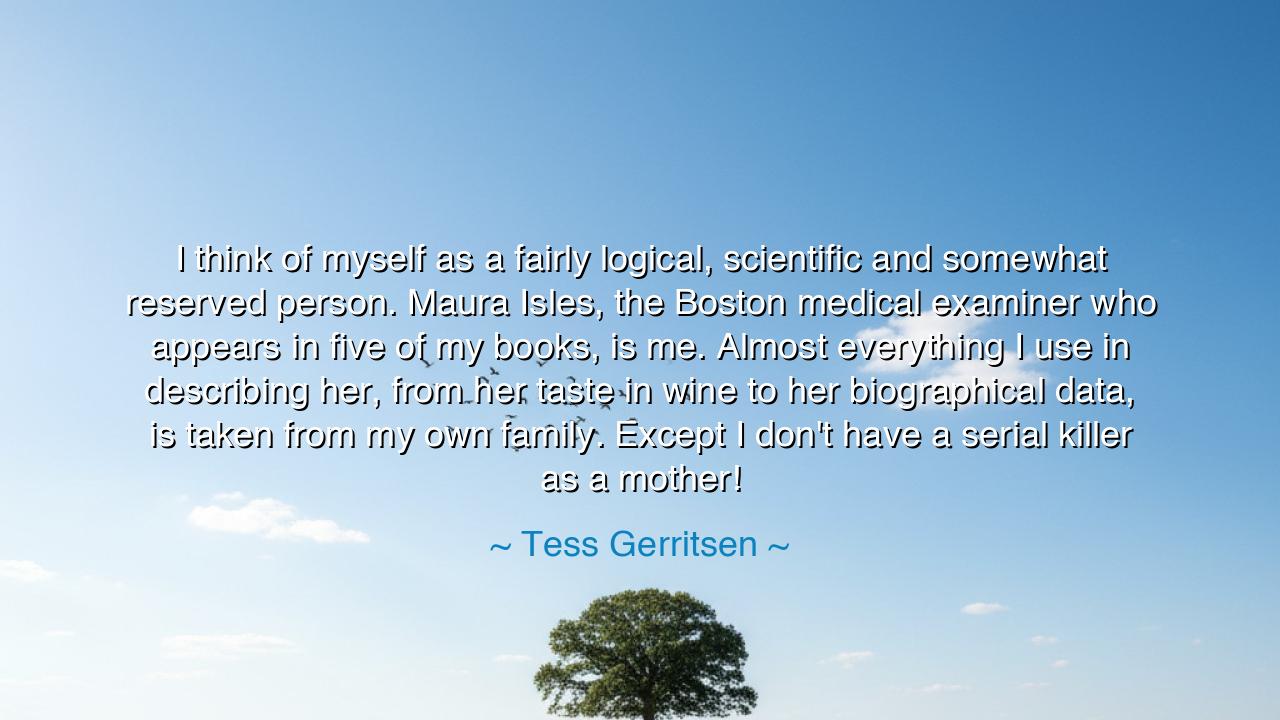
I think of myself as a fairly logical, scientific and somewhat
I think of myself as a fairly logical, scientific and somewhat reserved person. Maura Isles, the Boston medical examiner who appears in five of my books, is me. Almost everything I use in describing her, from her taste in wine to her biographical data, is taken from my own family. Except I don't have a serial killer as a mother!






The words of Tess Gerritsen—“I think of myself as a fairly logical, scientific and somewhat reserved person. Maura Isles, the Boston medical examiner who appears in five of my books, is me. Almost everything I use in describing her, from her taste in wine to her biographical data, is taken from my own family. Except I don't have a serial killer as a mother!”—reveal a timeless truth about the artist’s reflection within their creation. Beneath the wit and modest humor of her confession lies a deep and ancient insight: every act of creation is an act of self-revelation. No matter how fictional the tale, no matter how distant the world it portrays, the creator leaves their soul upon the page. The mask may change, but the face beneath it remains their own.
In the old traditions, poets and philosophers spoke often of the shadow-self—that hidden double who walks beside us, unseen yet inseparable. When Gerritsen speaks of Maura Isles as herself, she acknowledges that her character is not born from imagination alone but from the mirror of her own being. Through Maura, she expresses her logic, her discipline, her reserve—the qualities that define her both as a physician and as a storyteller. Yet through fiction, she gives these traits new life, exploring what they might become when placed in extraordinary circumstances. This is the alchemy of art: the transformation of life into story, and story back into truth.
The ancients would have called this process a form of divine imitation—mimesis, as Aristotle described it. The artist imitates not merely the world, but the essence of being itself. Gerritsen, who began her life in medicine, learned to study the body with precision and awe. In writing, she performs a similar dissection—but now it is the human soul she examines. Her character Maura Isles, cool in demeanor yet fierce in intellect, embodies the struggle to reconcile the rational with the emotional, the scientific with the human. And though Gerritsen jokes about lacking a “serial killer mother,” the remark reminds us that even in fiction’s darkest corners, truth must have roots in authenticity.
Consider the example of Mary Shelley, who, as a young woman, created Frankenstein. Her monster was not just a creature of horror—it was the reflection of her own fears: the loneliness of creation, the pain of rejection, and the danger of ambition untempered by compassion. Shelley, like Gerritsen, wrote herself into her work, whether consciously or not. Each great writer, from Homer to Tolstoy, from Virginia Woolf to Gerritsen, has carried within their tales a fragment of their own soul. For art that does not contain the heart of its maker cannot live beyond its age.
In Gerritsen’s words there also lies a subtle lesson in humility. She does not claim mastery over her character; rather, she admits kinship. To say “Maura Isles is me” is to acknowledge that creation is not domination but dialogue. The author and the character grow together, reflect one another, and in the end, teach one another. It is as though the artist is both sculptor and clay—shaping and being shaped at once. This is a truth as old as Pygmalion, who fell in love with the statue he himself carved, for in it he saw his own longing made flesh.
Yet Gerritsen’s self-portrait also speaks to something larger than art: the nature of identity itself. Each of us, whether we write novels or live quietly among our families, crafts stories about who we are. We build characters—the professional, the parent, the friend—and within each lies a reflection of our truest self, waiting to be discovered. Like Gerritsen, we must learn to see our own image in what we create, not with vanity, but with wonder. For to know oneself through one’s works is to approach wisdom.
The lesson in her quote, then, is twofold. To the creator, it is a call to authenticity: let your work arise from your truth, for that is where its soul will live. To the reader, it is a reminder that every story carries a heartbeat—listen, and you may hear the author’s pulse within the prose. Fiction, like life, is woven from what we know and what we dream. Between the lines of every tale lies a confession, a trace of the real. The artist who denies this loses both honesty and power.
So, dear listener, remember this: when you create, you do not simply build worlds—you reveal yourself to them. Like Tess Gerritsen, pour into your work your logic, your spirit, your fears, your humor, your lineage. Let even your shadow find a voice. And when others read what you have made, they will not only see your characters—they will meet you, eternal and alive, moving through the words as though through light itself.






AAdministratorAdministrator
Welcome, honored guests. Please leave a comment, we will respond soon